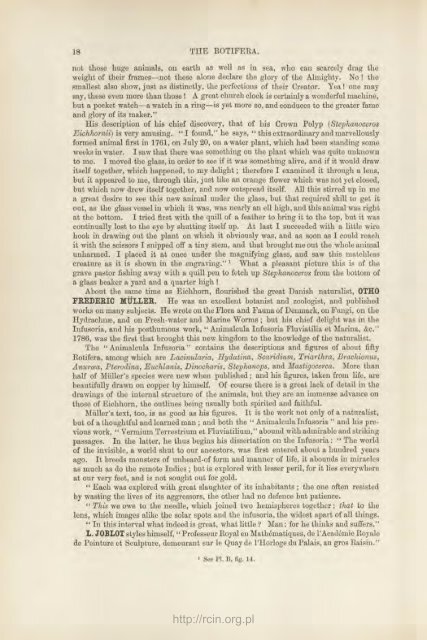You also want an ePaper? Increase the reach of your titles
YUMPU automatically turns print PDFs into web optimized ePapers that Google loves.
not those huge animals, on earth as well as in sea, who can scarcely drag <strong>the</strong><br />
weight of <strong>the</strong>ir frames—not <strong>the</strong>se alone declare <strong>the</strong> glory of <strong>the</strong> Almighty. No ! <strong>the</strong><br />
smallest also show, just as distinctly, <strong>the</strong> perfections of <strong>the</strong>ir Creator. Yea! one may<br />
say, <strong>the</strong>se even more than those ! A great church clock is certainly a wonderful machine,<br />
but a pocket watch—a watch in a ring—is yet more so, and conduces to <strong>the</strong> greater fame<br />
and glory of its maker."<br />
His description of his chief discovery, that of his Crown Polyp (Stephanoceros<br />
Eichhornii) is very amusing. " I found," he says, " this extraordinary and marvellously<br />
formed animal first in 1761, on July 20, on a water plant, which had been standing some<br />
weeks in water. I saw that <strong>the</strong>re was something on <strong>the</strong> plant which was quite unknown<br />
to me. I moved <strong>the</strong> glass, in order to see if it was something alive, and if it would draw<br />
itself toge<strong>the</strong>r, which happened, to my delight; <strong>the</strong>refore I examined it through a lens,<br />
but it appeared to me, through this, just like an orange flower which was not yet closed,<br />
but which now drew itself toge<strong>the</strong>r, and now outspread itself. All this stirred up in me<br />
a great desire to see this new animal under <strong>the</strong> glass, but that required skill to get it<br />
out, as <strong>the</strong> glass vessel in which it was, was nearly an ell high, and this animal was right<br />
at <strong>the</strong> bottom. I tried first with <strong>the</strong> quill of a fea<strong>the</strong>r to bring it to <strong>the</strong> top, but it was<br />
continually lost to <strong>the</strong> eye by shutting itself up. At last I succeeded with a little wire<br />
hook in drawing out <strong>the</strong> plant on which it obviously was, and as soon as I could reach<br />
it with <strong>the</strong> scissors I snipped off a tiny stem, and that brought me out <strong>the</strong> whole animal<br />
unharmed. I placed it at once under <strong>the</strong> magnifying glass, and saw this matchless<br />
creature as it is shown in <strong>the</strong> engraving." 1 What a pleasant picture this is of <strong>the</strong><br />
grave pastor fishing away with a quill pen to fetch up Stephanoceros from <strong>the</strong> bottom of<br />
a glass beaker a yard and a quarter high !<br />
About <strong>the</strong> same time as Eichliorn, flourished <strong>the</strong> great Danish naturalist, 0TH0<br />
FREDERIC MULLER. He was an excellent botanist and zoologist, and published<br />
works on many subjects. He wrote on <strong>the</strong> Flora and Fauna of Denmark, on Fungi, on <strong>the</strong><br />
Hydrachnae, and on Fresh-water and Marine Worms ; but his chief delight was in <strong>the</strong><br />
Infusoria, and his posthumous work, " Animalcula Infusoria Fluviatilia et Marina, &c."<br />
1786, was <strong>the</strong> first that brought this new kingdom to <strong>the</strong> knowledge of <strong>the</strong> naturalist.<br />
The "Animalcula Infusoria" contains <strong>the</strong> descriptions and figures of about fifty<br />
Rotifera, among which are Lacinularia, Hydatina, Scaridium, Triarthra, Brachionus,<br />
Anurcea, Pterodina, Euchlanis, Dinocharis, Stephanops, and Mastigocerca. More than<br />
half of Muller's species were new when published; and his figures, taken from life, are<br />
beautifully drawn on copper by himself. Of course <strong>the</strong>re is a great lack of detail in <strong>the</strong><br />
drawings of <strong>the</strong> internal structure of <strong>the</strong> animals, but <strong>the</strong>y are an immense advance on<br />
those of Eichliorn, <strong>the</strong> outlines being usually both spirited and faithful.<br />
Muller's text, too, is as good as his figures. It is <strong>the</strong> work not only of a naturalist,<br />
but of a thoughtful and learned man ; and both <strong>the</strong> " Animalcula Infusoria " and his previous<br />
work, " Yermium Terrestrium et Fluviatilium," abound with admirable and striking<br />
passages. In <strong>the</strong> latter, he thus begins his dissertation on <strong>the</strong> Infusoria : " The world<br />
of <strong>the</strong> invisible, a world shut to our ancestors, was first entered about a hundred years<br />
ago. It breeds monsters of unheard-of form and manner of life, it abounds in miracles<br />
as much as do <strong>the</strong> remote Indies ; but is explored with lesser peril, for it lies everywhere<br />
at our very feet, and is not sought out for gold.<br />
" Each was explored with great slaughter of its inhabitants ; <strong>the</strong> one often resisted<br />
by wasting <strong>the</strong> lives of its aggressors, <strong>the</strong> o<strong>the</strong>r had no defence but patience.<br />
" This we owe to <strong>the</strong> needle, which joined two hemispheres toge<strong>the</strong>r; that to <strong>the</strong><br />
lens, which images alike <strong>the</strong> solar spots and <strong>the</strong> infusoria, <strong>the</strong> widest apart of all things.<br />
" In this interval what indeed is great, what little ? Man: for he thinks and suffers."<br />
L. J0BL0T styles himself, " Professeur Royal en Matli^matiques, de l'Academie Royale<br />
de Peinture et Sculpture, demeurant sur le Quayde lTIorloge du Palais, au gros Raisin."<br />
1 See PI. B, fig. 14.<br />
http://rcin.org.pl
















